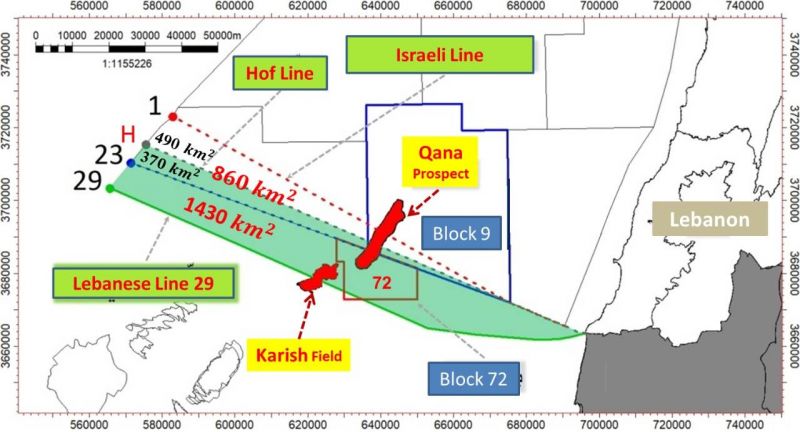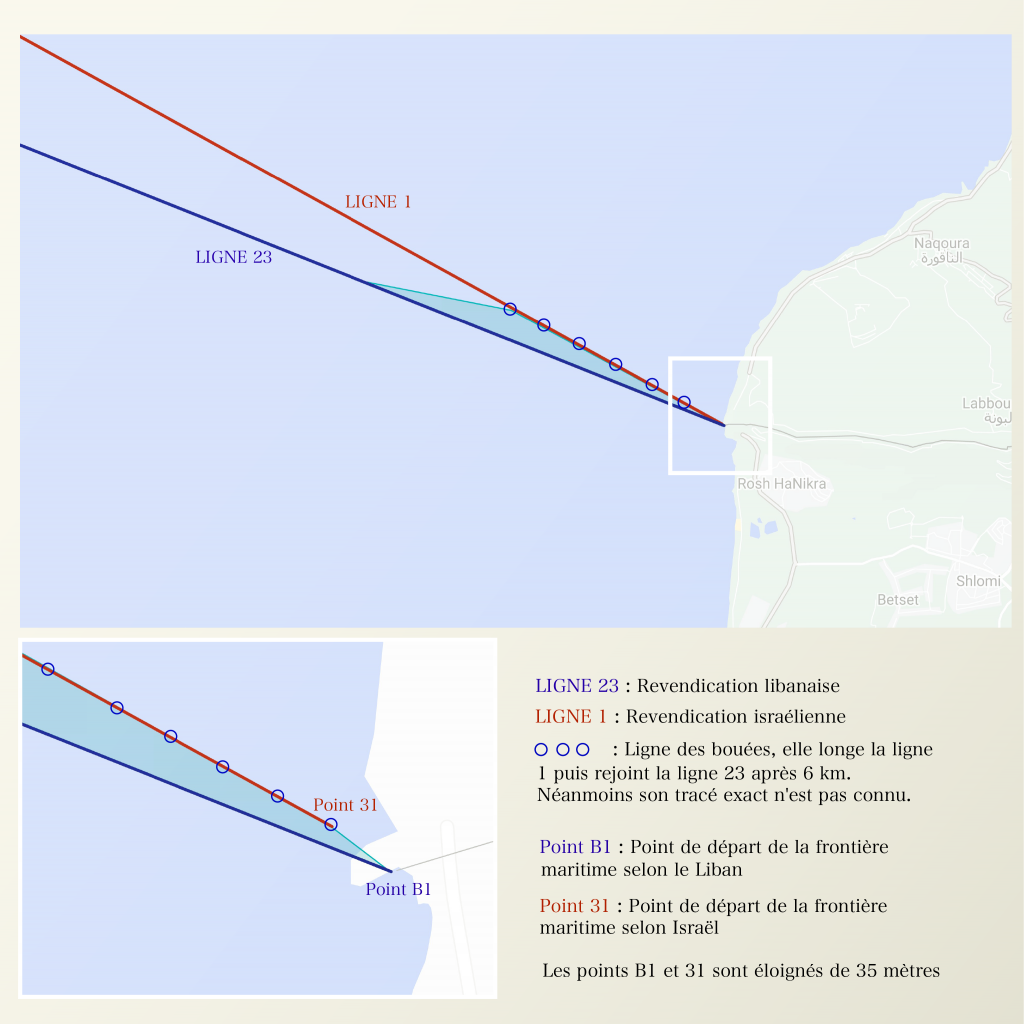Daniel Meierlecturer at Sciences Po Grenoble, associate researcher at UMR Pacte
Lebanon and Israel have just signed an agreement to demarcate a large part of their maritime border, which surprised analysts and commentators since Lebanon has never recognized the existence of the Hebrew state and only signed a ceasefire line agreement with it in 1949 as the basis for their common land border. Nevertheless, Yaïr Lapid, the Israeli Prime Minister in the middle of an election campaign, did not fail to present this agreement as de facto recognition of Israel by Lebanon. This claim was immediately denied by the Lebanese presidency and Hezbollah, whose Secretary General, Hassan Nasrallah, commented on Thursday evening, October 27, as soon as the agreement had been signed, stressing that " what was signed today by the President is neither an international agreement, nor recognition of Israel, nor normalization ". So what exactly is it? And how can we explain the eagerness of the leader of the Shiite group, Israel's sworn enemy, to welcome this agreement? In short, how can we explain the conclusion of such a maritime agreement between two states that are still technically at war?
If it's tempting to turn to legal experts for a qualification of the agreement agreement signed, the type of document signed alone cannot sum up the process process and the stakes involved. Lebanese lawyers can be trusted to have lawyers to have prepared a legal package that avoids any confusion between this agreement and a treaty: no face-to-face meetings between the two delegations face-to-face throughout the negotiation process, then at the signing of the the signing of the agreement, and the initialling of two separate documents on which signatures of the other party do not appear. But above all," points out Rizk Zgheib, lawyer and lecturer and lecturer in law and political science at Saint-Joseph University in Beirut, the document signed document does not qualify as a treaty insofar as it does not provide for sanctions in the event of non-compliance with its provisions.
It is perhaps here, on the flip side of what this agreement is not, that its interest for the Shiite party lies. In any case, it has already enabled Hassan Nasrallah to make it clear that his party had given no security guarantees. Moreover, the agreement, it should be remembered, is not complete, since there is still disagreement between the two parties over the first few kilometers of the border line - which has given rise to the appearance of a "separative free zone" - pending either negotiations on the initial point of the maritime border, or an armed confrontation to "liberate the 2.5 km2" of this zone, as Hassan Nasrallah declared during his televised speech on October 29. Finally, for Hezbollah, this agreement takes place in a deleterious internal context, which should enable the political elites, whose legitimacy has been dented by the country's catastrophic economic situation, to regain their virginity. Although partial and temporary, the agreement should enable the exploitation of the southern blocks of Lebanon's potentially hydrocarbon-rich Exclusive Economic Zone (EEZ), in particular the "Qana" gas field. By joining the Lebanese state in celebrating the success of this agreement, Hezbollah wished to recall its decisive role as a state-builder, which, beyond the case of this agreement, testifies to its hold on strategic issues on state borders, as was the case in the past in the south and east of the country.
Genesis of a complex agreement on a minefield
So how did this agreement come into being? And why is its perception so so ambivalent among the population, with the most virulent denouncing the that sovereignty has been mocked? Two stages need to be need to be identified: the first, which forged the issue until 2011 and that which, since 2012, has formed the basis of the negotiations which have just led to this agreement.
The first maritime delimitation took place with Cyprus in 2007, when seven maritime border points (1-7) were defined by Lebanese agents. Parliament did not ratify this incomplete initial draft, as it lacked the triple maritime points to the north and south with Syria/Cyprus and Israel/Cyprus respectively, which had not been identified. So, when a new delimitation was carried out in 2009, point 1 was replaced by point 23, 17 kilometers further south, identified by the Lebanese team on the basis of a British Admiralty map as the triple Lebanese-Israeli-Cypriot maritime boundary. This 2009 delimitation was intended to identify the entire Lebanese exclusive economic zone (EEZ), and the coordinates of all these points were transmitted to the United Nations in November 2011, following the adoption of a law and decree concerning the maritime zone and its borders, so that Lebanon could assert its rights to exploit its seabed. At the same time, Israel, also keen to exploit its seabed and assert its rights over its EEZ, signed a border demarcation agreement with Cyprus in December 2010. In so doing, Israel used point 1 of the incomplete 2007 Lebanese route for its triple border with Lebanon and Cyprus, instead of the triple point 23 of 2009. This maneuver, orchestrated by the Netanyahu government and endorsed by the Israeli cabinet in July 2011, created a disputed area of some 860 km2 where the EEZs of Israel and Lebanon overlapped (Figure 1).

Figure 1: Boundaries and initial disputes
(source: Hisham Ashkar 2014)
A second period began the following year, when the United States sought to mediate a negotiated solution. The US State Department's first envoy, Fredrick C. Hof, proposed a line, known as the "Hof Line", dividing the disputed area in such a way as to grant 55% to Lebanon and 45% to Israel. These negotiating terms betrayed not only the absence of any legal basis for Israel's claim, but also the partiality of the American mediator. For its part, Lebanon refused to accept any division of this disputed area, before the vicissitudes of Lebanese politics in the face of the Syrian crisis swallowed up the negotiations. In 2017-2018, the political class, which has since lost legitimacy, sought to revitalize the maritime dossier by raising hopes of significant oil and gas resources in the Lebanese seabed, when it awarded the exploitation license for blocks 4 (center) and 9 (southern border) to the Franco-Italian-Russian Total-ENI-Novatek consortium. However, the first drillings in Block 4 in 2020 and 2021 proved very disappointing.
As a counterpoint, the diplomatic initiative resumed in autumn 2020 under the aegis of the United States, on the basis of a "framework agreement" drawn up with the head of parliament, the Shiite Nabih Berri, who became more cooperative following the American sanctions affecting some of his party's cadres. The process, under the auspices of the American David Schenker, Assistant Secretary of State for the Middle East, was also welcomed by the Israeli authorities, who stressed that it was the result of three years of American diplomatic efforts. As explained by natural resources specialist Laury Haytayan, the framework of these negotiations was centred on, but not limited to, the disputed 860 km2 area. This the Lebanese delegation was quick to exploit in the second round of negotiations, bringing out an alternative route proposed by the British Hydrographic Office in 2011, which, again based on the principles of equidistance advocated by the United Nations Convention on the Law of the Sea (UNCLOS), chose not to give any effect on the orientation of the border line to an uninhabited Israeli islet, Tekhelet, some fifty metres long and close to the border zone. The result was a new border line further south, line 29, supported by the army and a sovereignist political fringe, increasing Lebanon's territorial claim by 1,430 km2 and even encroaching on Israel's Karish gas field (Figure 2). This maximalist stance was clearly not to Washington's taste, nor of course to Tel Aviv's, leading to a freeze in negotiations in December 2020, during which Lebanese President Michel Aoun did not fail to raise tensions by threatening to register Line 29 as the new delimitation of the Lebanese EEZ with the UN.

(source: L'Orient-Le Jour)
It was finally in the autumn of 2021 that a new American negotiator, Amos Hochstein, moved the dossier forward. The arrival on the scene of the initiator of the 2020 framework agreement and chief negotiator in the Biden administration demonstrated the American determination to achieve a breakthrough on this issue at this stage of the process, and to put pressure on the parties involved. What followed was a series of ups and downs, depending on the comings and goings of the American mediator, with a critical phase in early summer 2022 when Hezbollah sent three drones to the Karish gas field to send a threatening message about its intentions should Israel attempt to exploit the field without first allowing Lebanon to exploit its hydrocarbon resources via a border demarcation agreement. Thus positioned as the guardian of the nation's interests, Hezbollah did not fail to claim victory when, a few weeks later, Amos Hochstein arrived in Beirut with a positive reaction from Israel to the Lebanese idea of including the entire Qana gas field under Lebanese sovereignty, even though it encroaches on Israel's EEZ. Israel then proposed a quid pro quo by recovering surface area with a line 23 folded onto the Hof line at Block 8.
Another scenario was not to modify Line 23 but to envisage a two-stage solution for the Qana field, with the surface area under Israeli control and the seabed under Lebanese control. In the end, Lebanese sovereignty over the entire Qana field was granted in exchange for the payment of royalties linked to its exploitation by the oil company in charge (Totalenergie). Another issue linked to the initial segment of the maritime border line was even more difficult to negotiate, with each party sticking to its own position. Lebanon, which imperatively wished to retain point B1 as the initial land point of the maritime border, had to give in to Israel's demand to retain the "line of buoys" starting from point 31 (at sea), located further north than line 23. However, in order not to deny its position, Lebanon was guaranteed maritime sovereignty up to line 23, in return for the creation of a "separating free zone" between the two lines (Figure 3).

(source : L'Orient-Le Jour)
Two lessons can be drawn from this complex orogeny on a minefield: the need to back such a negotiation process with tangible gains, namely the exploitation of hydrocarbon resources. And the use of a solution that is not yet complete: thanks to the creation of a buffer zone, it leaves in abeyance a major dispute, that of the starting point of the maritime boundary insofar as it is also the initial point of the land boundary.